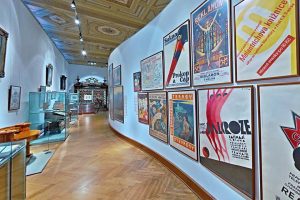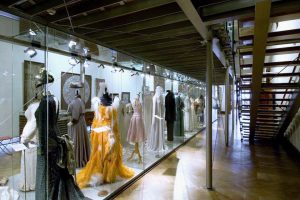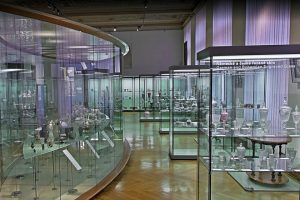Vojtěch (Adalbert) Lanna Jr. (1836–1909) was the most illustrious member of his family that had arrived in Bohemia from Upper Austria in the 18th century. His father, Vojtěch Lanna Sr. (1805–1866) was one of the founders of Czech industry, he was a businessman in the lumber trade, transport construction, river regulation and railway building. Through the expansion of these activities, Lanna Jr. gradually established one of the most important construction companies in Austria-Hungary. He engaged in the construction and improvement of most of the principal, still-existing, railway lines and watercourses. The company’s headquarters were located in the Lanna Palace on Hybernská Street in Prague, where the family lived. Lanna’s successful entrepreneurship is also imprinted in the two stately villas that Vojtěch Lanna used mostly for relaxation. The first edifice was built in nearby Bubeneč, the second one in Gmunden, Austria.
Lanna invested a considerable portion of the huge profits in extensive philanthropic activities and the support of public institutions. His meritorious pursuits were acknowledged not only by the high esteem in which he was generally held but also by his ennoblement and appointment to many distinguished posts. For instance, Vojtěch Lanna Jr. was appointed a life peer in the House of Lords of the Imperial Austro-Hungarian Council.
Vojtěch Lanna was one of the founders of this museum. His interest in the creation of a museum devoted to the applied arts was based on his passion for art collecting and his concern with the improvement of the cultural and economic situation in Bohemia. Still before the official establishment of the Museum of Decorative Art in 1885, Lanna, who was a seasoned art connoisseur, had arranged the purchase of many exhibits for the evolving museum collections. Especially in the initial years of the young institution, loans from his private collection formed the nucleus of the emerging permanent collection.
For decades, he held the post of chairman of the museum’s administration committee and was an advisor to and colleague of the institution’s first directors, namely Karel Chytil and František Borovský. Frequently, Vojtěch Lanna negotiated the purchase of whole collections that he had visited during his travels around Europe. Every year, he donated dozens of objects to the museum. After the museum had expanded and moved from the Prague Rudolfinum to its own building, he loaned in 1905 his collections for exhibition that filled four rooms of the new building’s second floor. The peak of his patronage was his gift of more than one thousand pieces of rare historic glass – a generous gesture with which Vojtěch Lanna celebrated his seventieth birthday in 1906.
The Museum of Decorative Arts in Prague manages more than half a million collections and their collections. The collection began to exist before the official opening of the museum in 1885. It is a testament to all the basic materials and techniques used in the arts and crafts and covers the period from antiquity and antiquity to the present. Many units, such as the glass collection, are among the most comprehensive and valuable worldwide.
The wealth of the museum is the result of the work of its directors and curators, whose professional activities created the Czech history of art crafts. Together with them, collectors and supporters of the museum contributed significantly to the building of the collections. Many of them donated valuable items, funds and often the results of their lifelong collecting activities to the museum.
The Museum of Decorative Arts in Prague wants to be a modern institution of the 21st century. He does not forget that this is possible due to the dedication of his predecessors and generosity, often unjustly forgotten personalities who supported the museum in the past. We therefore consider it an honor to make their legacy known to the wider public. At the turn of 2019 and 2020, we are gratefully commemorating the 110th anniversary of the death of the patron and co-founder of the museum collections of Vojtěch Lanna Jr..
Museum of Decorative Arts In Prague
Founded in 1885, the Museum of Decorative Arts in Prague (UPM) is housed in a Neo-Renaissance edifice built in 1897–1901 after the designs of architect Josef Schulz. The Museum’s rich collections include decorative and applied arts and design work ranging from Late Antiquity to the present day, with focus on European objects, particularly arts and crafts created in the Bohemian Lands. The impressive interior of the permanent exhibition “Stories of Materials” offers visitors an excursion into the history and development of decorative arts: glass and ceramics, graphic art and design, objects made in metal, wood and other materials, jewelry, clocks and watches, textiles, fashion, toys and furniture.
An integral part of the Museum is the largest Czech library specializing in the arts and related fields. The Library offers visitors on-site loan and copying services, database access and searching in the ART (Art and Architecture) subject gateway.
The UPM presents its holdings at branch museums at the chateau in Kamenice nad Lipou and the Textile Museum in Česká Skalice. The Museum also administers the Josef Sudek Gallery on Úvoz Street near Prague Castle.
Our objective is to ensure that the Museum of Decorative Arts in Prague is a place for innovative learning that facilitates the understanding of the significance of objects of decorative arts and design, in combination with architecture and other art disciplines. We aspire to contribute to the improvement of the quality of life and the preservation of creativity in an increasingly uniform environment and to create a forthcoming space for the engagement of the public and the discussion of the cultural milieu and the world that surrounds us.






